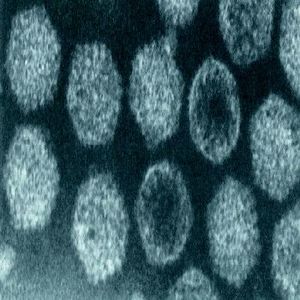Infectious Bursal Disease Virus
WIKI IN PROGRESS
Infectious Bursal Disease Virus
Characteristics of the symbiont/pathogen
The infectious bursal disease virus is a small, non-enveloped virus, that is a part of the family Birnaviridae (2). The virus has a single capsid shell made up of 32 capsomers. It has a diameter of 60 to 70 nanometers. The sequenced genome of the virus is broken down into two RNA segments. The first, larger segment is about 3,400 base pairs and the second, smaller segment is about 2,800 base pairs long (2).
Characteristics of the host
The virus causing infectious bursal disease mainly effects chicken and other avian animals. Young chicks are effected within the first six weeks of life (3). The viral disease causes necrosis of lymphocytes and specifically affects the bursa of Fabricius, a lymphoid organ (3). Chicken are the only avian species the ate susceptible to the clinical disease (4).

Host-Symbiont Interaction
Chicken acquire the pathogenic IBD virus via oral route where it is then transported to other organs and tissue by phagocytic cells (4). the host and symbiont have a parasitic relationship where the virus attacks lymphoid cells and causes apoptosis of surrounding cells.
What kind of interaction do host and symbiont have? How is the host affected by the relationship? How does the host acquire and transmit the symbiont? Is the interaction obligate or facultative?
Molecular Insights into the Symbiosis
Describe molecular/genetic studies on the symbiosis.
Ecological and Evolutionary Aspects
What is the evolutionary history of the interaction? Do particular environmental factors play a role in regulating the symbiosis?
Recent Discoveries
Describe two findings on the symbiosis published within the last two years.
References
Edited by Helena Shadid (Helenashadid), students of Grace Lim-Fong
This template is just a general guideline of how to design your site. You are not restricted to this format, so feel free to make changes to the headings and subheadings and to add or remove sections as appropriate.
